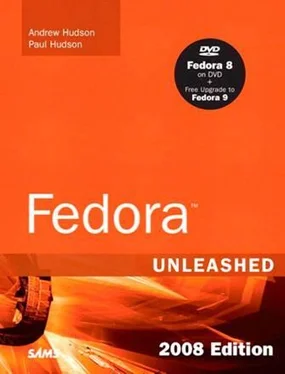We have also substantially rewritten several chapters and introduced new ones, such as Chapter 4, "Command-Line Quick Start," and others. This book also looks at the three main ways in which you can obtain Fedora: by using the DVD, Live CD, and KDE Live CD media. There are many changes to this book, and it's taken a long time to come to fruition.
Licensing
An important thing to consider, given Linux's unique place in the market, is the licensing situation surrounding Fedora. Believe it or not, the software that you are about to install is 100% free in every sense of the word. You may have handed over your money for this book, but you can download the software itself for free from the Internet, or you can purchase a CD for a small price (usually to cover postage and packaging). Not only that, but you are able to examine the code behind all the packages and make changes yourself, if you want to. This is in stark contrast to other vendors, who charge you for the operating system and then prevent you from making any changes at the code level. It is this key difference that makes Linux into an open source operating system. Surprisingly enough, these vendors never actually sell you the software for you to own; rather, they give you only the right to use the software. As mentioned before, this is certainly not the case with the software included with this book. You are entirely free to make copies of the DVD, share them with friends, and install the software on as many computers as you want — we encourage you to purchase additional copies of this book to give them as gifts, however. Be sure to read the Read Me file on the DVD included with this book for important information regarding the included software and disc contents. Look under the /usr/share/doc/fedora-release-8directory after you install Fedora to find a copy of the GNU GPL (along with copies of other software licenses). You will see that the GPL provides unrestricted freedom to use, duplicate, share, study, modify, improve, and even sell the software.
You can put your copy of Fedora to work right away in your home or at your place of business without worrying about software licensing, per-seat workstation or client licenses, software auditing, royalty payments, or any other types of payments to third parties. However, be aware that although much of the software included with Fedora is licensed under the GPL, some packages on this book's DVD are licensed under other terms. There is a variety of related software licenses, and many software packages fall under a broad definition known as open source. Some of these include the Artistic License, the BSD License, the Mozilla Public License, and the Q Public License.
For additional information about the various GNU software licenses, browse to http://www.gnu.org/. For a definition of open source and licensing guidelines, along with links to the terms of nearly three dozen open source licenses, browse to http://www.opensource.org/.
Who This Book Is For
This book is for anyone searching for guidance on using Fedora, and primarily focuses on Intel-based PC platforms. Although the contents are aimed at intermediate to advanced users, even new users with a bit of computer savvy will benefit from the advice, tips, tricks, traps, and techniques presented in each chapter. Pointers to more detailed or related information are also provided at the end of each chapter.
Fedora's installer program, named Anaconda, makes the job of installing Linux as easy as possible. However, if you are new to Linux, you might need to learn some new computer skills, such as how to research your computer's hardware, how to partition a hard drive, and occasionally how to use a command line. This book will help you learn these skills and show you how to learn more about your computer, Linux, and the software included with Fedora. System administrators with experience using other operating systems will be able to use the information presented in this book to install, set up, and run common Linux software services, such as the Network File System (NFS) , a File Transfer Protocol (FTP) server, and a web server (using Apache, among other web servers).
What This Book Contains
Fedora Unleashed is organized into seven parts, covering installation and configuration, Fedora on the desktop, system administration, Fedora as a server, programming and housekeeping, and a reference section. A DVD containing the entire distribution is included so that you will have everything you need to get started. This book starts by covering the initial and essential tasks required to get Fedora installed and running on a target system.
If you're new to Linux, and more specifically, Fedora, first read the chapters in Part I, "Installation and Configuration." You will get valuable information on the following:
► Detailed steps that take you by the hand through various types of installations
► Critical advice on key configuration steps to fully install and configure Linux to work with your system's subsystems or peripherals, such as pointers, keyboards, modems, USB devices, power management, and — for laptop users —PCMCIA devices
► Initial steps needed by new users transitioning from other computing environments
► Configuration and use of Gnome and X, the graphical interface for Linux
Part II, "Desktop Fedora," is aimed at users who want to get productive with Fedora and covers the following:
► Discovering the many productivity applications that come with Fedora
► Surfing the Internet and working with email and newsgroups
► Using Fedora to listen to music and watch video
► Using Fedora to download and manipulate images from digital cameras
► Setting up local printers for Fedora
► A look at the current state of gaming for Linux
Moving beyond the productivity and desktop areas of Fedora, Part III, "System Administration," covers the following:
► Managing users and groups
► Automating tasks and using shell scripts
► Monitoring system resources and availability
► Backup strategies and software
► Network connectivity, including sharing folders and securing the network
► Internet connectivity via dial-up and broadband connections
Part IV, "Fedora As a Server," looks at the opportunities provided by every Fedora system by covering the following:
► Building and deploying web servers
► Database creation, management, and manipulation
► File and print servers
► Using FTP for serving files across the Internet and local networks
► Building and deploying email servers with Postfix as well as managing mailing lists
► Creating remote access gateways and services
► Configuring DNS for your network
► Using LDAP for storing information on users and security
► Configuring a local news server
Part V, "Programming Linux," provides a great introduction into ways in which you can extend Fedora's capabilities even further, using the development tools supplied with it. This part covers the following:
► Programming in Perl, using variables and scripting
► An introduction to the Python language
► Writing PHP scripts and linking them to databases
► An introduction to the mono programming language
► C and C++ programming tools available with Fedora, and how to use the GNU C Compiler (gcc)
Part VI, "Fedora Housekeeping," looks at some of the more advanced skills you need to keep your system running in perfect condition, including the following:
► Securing your machine against attack from outsiders and viruses
► Performance tuning
► Command-line master class
► Advanced yum
► Kernel and module management and compilation
Читать дальше





![Andrew Radford - Linguistics An Introduction [Second Edition]](/books/397851/andrew-radford-linguistics-an-introduction-second-thumb.webp)






